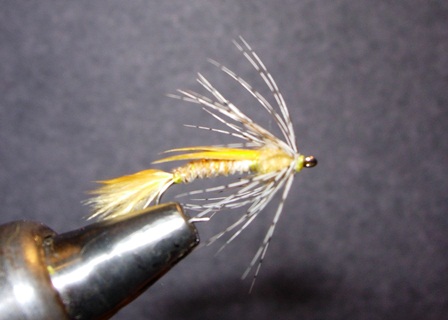Description
Yes, I’m on a Caddis kick. In fact, next
month this column will feature a reprise of
my Stick Caddis, in preparation for the
Upper Sacramento outing. For the time being,
though, let’s consider another aspect of the
life cycle of the Caddisfly: the emergent
stage.
Last month’s fly, the Flashy Chick Caddis,
represents a Caddisfly diving to the bottom
to “oviposit” (entomologist’s term for the
egg-laying stage). Once those eggs hatch,
and the insect goes through its larval and
pupal stages, it will assume the form of an
adult and swim to the surface, break through
the surface skin, and fly away. Of course,
predatory trout munch them as they swim
upward, and also feast on those having
trouble breaking the surface tension.
The Princely Caddis Emerger was designed to
suggest an emergent Caddisfly swimming to
the surface. Like the Flashy Chick, I use it
as a stinger at the end of my short line rig
and, where possible, swing it down when the
short line drift is done. In my Upper Middle
Fork “laboratory” this fly, fished in that
manner, has outstripped my expectations. So,
crank a few of them and give them a try.
Tying Instructions
|
|
1.
Smash the hook barb. Wrap 3 turns of
.015 weight at the thorax area,
which will be about 2 eye-widths
behind the hook eye.
2.
Cover the shank and weight with
thread, leaving it at the back of
the barb.
|

|
|
|
|
3.
Tie in a tail made with a small
pinch of ginger or amber marabou;
keep it sparse, and the length
should be no longer than the hook
shank.
|

|
|
|
|
|
4.
At the same spot, tie in a 3” length
of extra small copper wire and a
small slip of light colored turkey
primary wing feather. Tie the
feather in by the tip.
I like to use the feathers that have
a golden color to them.
|

|
|
|
|
|
5. Bring the turkey and copper wire
together, and grab them with a
hackle plier near their bottom.
Twist them into a rope, in a
counterclockwise direction. Wrap the
rope up the shank to the thorax area
(see above). Tie the rope off at
that point.
|

|
|
|
|
|
6.
Cut or strip two ginger or amber
biots from the stem. Tie them in
just ahead of the thorax just as you
would the biots for a Prince Nymph,
and wrap back over them to the
thorax area (in other words, to
about the middle of the weight
area).
|

|
|
|
|
|
7.
Dub
a nice thorax over the weight area
but leave a small amount of room
behind the hook eye for the next
step.
|

|
|
|
|
|
8.
Tie in a small partridge feather by
its tip and take a couple of wraps
in front of the thorax; tie off the
feather and smooth it rearward while
wrapping a few more times in front
of it. Whip finish.
|

|
|
|
|
|
|
|
|
Tying
Tips:
1. Step 3 is important. The marabou
should be relatively sparse, and the
length no longer than the shank.
When “trimming” the marabou to
length, do it after tying it on but
don’t use scissors. Pop it off to
the proper length using your
thumbnail and forefinger. Cutting it
with scissors produces too sharp of
an edge.
2. Step 4 consists of a technique
new to most tyers. When tying in the
material to be wrapped with the
copper wire, it is important to tie
it in by the tip because when you
twist the combined materials the
portion nearest the hook will not
twist properly (or even at all) if
it is thicker than the portion
attached to the hackle pliers.
3. The light turkey feather I use
has an amber hue to it. It is a
Hareline product called “Ozark Oak”
turkey feathers. If you can’t find
that color, just substitute any
light colored turkey.
This pattern is a modified form of
soft hackle fly. So, as in the case
of last month’s fly, tie one of
these gems to the end of your tippet
and fish it like you would a wet fly
(i.e., swing it). Alternately, tie
it as a stinger to the bend of the
bottom fly on a short line rig; then
do a short line drift but let it
swing into a wet fly swing.
 |
|
